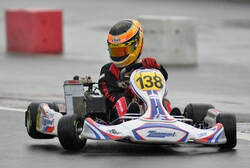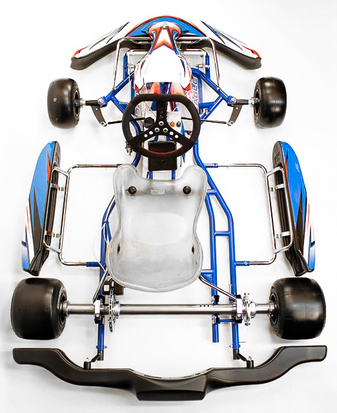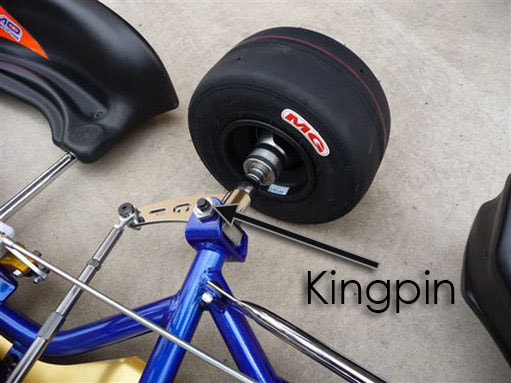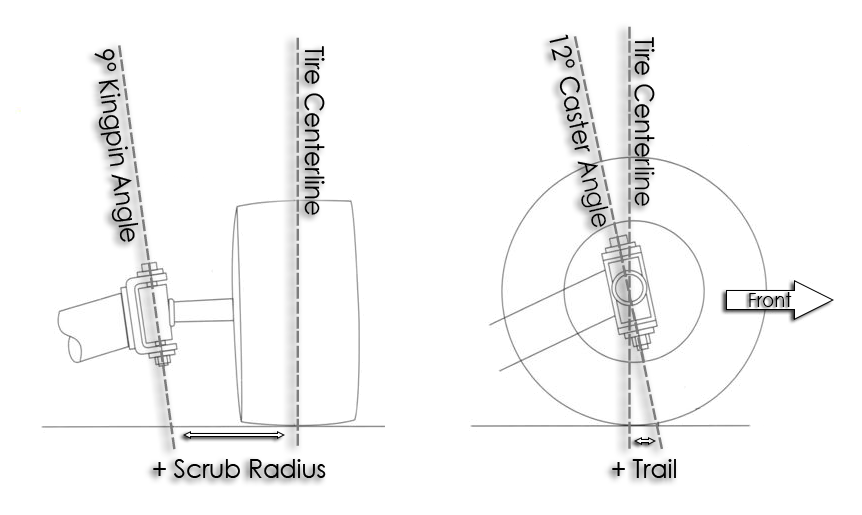A Three-Wheeled Vehicle?
 A kart must unload the inside rear tire to turn effectively.
A kart must unload the inside rear tire to turn effectively.  When turning, the inside wheel travels on a shorter path than the outside wheel.
When turning, the inside wheel travels on a shorter path than the outside wheel.  A kart's solid axle causes both rear wheels to rotate at the same speed.
A kart's solid axle causes both rear wheels to rotate at the same speed. Once that rear tire unloads, which it should be throughout most of the turn, basically the only thing that affects the balance of the kart is the location of the center of gravity in relation to the three loaded tires. That’s it. There are some nuances to this, but most of the adjustments you can make have absolutely no effect on a properly cornering kart. Most adjustments on a kart are only about ways to get that rear inside tire unloaded the proper amount. Think of a bar stool that only has three legs. It is never wobbly unlike a four legged bar stool that needs legs of perfectly equal length in order to not wobble. This is the difference between cars and karts. Cars are the four-legged barstools, and karts are the three. In simplistic terms, you can use a car's ability to “wobble” to alter the balance of the car. This is done through varying front and rear roll resistance and therefore load transfer. Our three-legged barstool kart however, is balanced on only three tires during a corner. It has no "wobble" because it essentially has 100% rear load transfer and the rear outside tire's load and therefore grip potential becomes basically static. We'll come back to this later on, but first let's look at ways we can go about creating this three-wheeled kart.
Kart Jacking through steering geometry
To picture this, you might pretend the kart is now a seesaw. One front tire and the diagonally opposite tire are the pivot points and the two other tires can bounce up and down. In reality, although you can feel some wobble in the kart, the tires normally don’t move up and down enough to really be able to seesaw but this should illustrate the concept. On a kart, this lifting of the tire is called a jacking effect, as if you had taken a jack and lifted the kart. A lifting or lowering of a car or kart chassis in relationship to the ground is called jacking. The amount of jacking from steering geometry is directly related to the distance between the tire's contact patch and the steering axis as well as the angle the tire rotates about.
Ok, now here is the trick to how this works. The caster and scrub radius together cause the wheel to lift up when you turn the steering one way and go down when you turn it the other way. So one wheel is going up and one is going down in relation to the kart chassis as you steer. If you have access to a kart, this is pretty easy to see when you turn the steering as the angles and distances are relatively large. Even on some stiffly sprung cars however, you can often see the chassis rise and tilt as you turn the steering to full lock. Exaggerating the distances and angles in your mind might help you visualize this as well. Imagine if the caster were tilted all the way to 90 degrees where it was parallel to the ground. Turning the steering would then make the wheel go directly up and down. You could also then imagine the spindle were five feet long so it would cause the tire to rise above and below the chassis a full five feet as you turned the steering.
Remember that we are really only talking about one angle and one distance however, so the kingpin angle together with mechanical trail also cause a jacking effect. These cause the outside wheel to go down and the inside to go up in relation to the chassis as well. This might be a little harder to visualize, but try exaggerating in your mind the angles and lengths and you should hopefully see it. In a kart, this effect is often much smaller than caster combined with scrub radius, but nonetheless it does have an effect.
 The large bolt connecting the spindle assembly to the chassis is called the kingpin.
The large bolt connecting the spindle assembly to the chassis is called the kingpin. So how much jacking through steering geometry do we want? Well, we can’t say right now because other factors such as chassis flex and center of gravity come into play, and so like most things in racing you are going to be facing a compromise. But understanding how to alter the jacking effect through your front-end geometry is the first piece of the puzzle.
Kart JACKING THROUGH Chassis Flex
To understand roll resistance, it might be easiest to look at cars. In a nutshell, cars use differing roll resistances at the front and rear to distribute the load differently between the front and rear tires. Whichever end has more roll resistance will load up the outside tire and unload the inside tire more quickly during a corner. Due to tire load sensitivity, this alters the balance of the car. If you read our tire science article you will learn about tire load sensitivity. On a kart however, roll resistance is primarily used to unload the inside rear tire so that you can turn properly without terminal understeer. To accomplish this, the rear of a kart has much more roll resistance than the front to help unload that rear inside tire during cornering. Together with the jacking effect caused by steering geometry, the kart becomes a three-wheeled vehicle. The entire weight of the rear of the kart is now on the outside tire only. Any further load transfer will only take place at the front of the kart and the rear tire load and therefore grip potential is essentially static. Only by making the rear tire work better through camber or pressure changes can we increase its grip potential.
So what causes this roll resistance? Cars have sophisticated suspension systems with multiple freely moving joints, springs, and dampers. In comparison, a kart's roll resistance is primarily based on how much “stuff” there is between the center of gravity where the driver sits and the tire contact patch. As an example, to increase rear roll resistance, you could put on a stiffer rear axle, stiffer seat, put on the rear chassis stiffening bar, add seat struts, stiffer rear hubs, etc... None of these are directly adding to or removing grip from the rear, they are simply resisting the kart's weight more, which increases roll resistance at that end.
So what happens at the front of the kart where the roll resistance is much lower? The chassis will bend more than the rear. To visualize this, we again like to exaggerate. Pretend the front spindle is made out of a wet noodle instead of steel. This would lower your front roll resistance to basically nothing. Assuming it would actually support your weight while driving, imagine you go around a corner. What would happen? The front part of the chassis where the spindle attaches would grind into the ground. But what would happen to the diagonally opposite inside rear tire? It would be about 3 inches in the air. Remember the seesaw. Alternatively, you could pretend your rear axle is made out of a noodle. This would significantly lower your rear roll resistance. Taking a corner now would cause your inside front wheel to go up in the air.

Also don't forget about the other major component that can have an effect on chassis flex. You! The driver can knowingly or not alter the roll resistance by a fair amount. During a corner, the driver can push forward and outward on the steering wheel to increase roll resistance at the front and reduce the jacking effect. Pushing your feet into the heel stops will aid stiffening as well. Pulling inward on the steering wheel will have the opposite effect. This is probably not something you would want to rely on, but if you discover your kart is hopping in a certain corner, you could push on the steering wheel to minimize the hop until you are able to make adjustments to the kart. This could also save time while tuning by allowing the driver to experiment with higher and lower stiffness without having to change out parts.
So which is better, the jacking effect through steering or through chassis flex? Well like everything else in racing, it is a compromise. Jacking through steering geometry is directly proportional to how much you turn the steering wheel, so in tight turns the inside rear will be unloaded more than on fast sweepers. Chassis jacking through flex however, is directly proportional to the amount of lateral g force you experience. There will be the same amount of jacking on fast and slow corners if the level of grip is the same. This will cause the amount of jacking to change as grip levels change however. Your basic goal is generally to have the rear inside unload just enough so it is not pressing into the ground and no more. If the kart jacks so much that the rear tire is high in the air you will often have handling problems such as a kart that tends to hop as the rear outside tire's camber goes too positive and suddenly loses grip. Another factor in determining proper chassis flex is that it also acts as your "suspension." The stiffer a chassis is, the quicker it will react to your inputs, so when you have lots of quick transitions you could use a stiffer chassis to gain time. On a bumpy circuit however, you would need a softer overall setup to keep the tires on the ground. Again, it is a tradeoff.
Remember though, none of these changes will add or remove grip so they aren't going to directly have a significant effect on the kart's performance. At this stage, we are simply trying to unload the inside rear and within a reasonable range, many different combinations of settings can work. As we've learned however, once the inside rear becomes unloaded, the rear grip potential basically becomes static. At that point, the center of gravity location in relation to the tires becomes the overriding factor in the way the kart handles. In part 2, we'll delve into the great importance of the center of gravity of a kart and look at how we can use what we've learned to find some general goals to aim for with our setup.
I hope you enjoyed this article. If you are interested in a complete guide to the physics of racing, we also offer The Science of Speed book series, available through our bookstore or at popular retailers such as Amazon.





